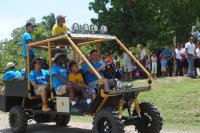Humanitarian Engineering in High School
High school students in Alabama design prosthetic devices and tackle other real-world challenges with a village in Honduras.
Your content has been saved!
Go to My Saved Content.A teacher who felt like a failure when he was in school now takes delight in unleashing his students’ creativity and problem-solving skills to engineer inexpensive solutions for real-world challenges.
“I was that kid in school that nobody believed in,” says Brian Copes, a carpenter turned engineering teacher. “Teachers gave up on me. I couldn’t connect core subject knowledge with real-world applications, so I tuned them out.”
He’s now a role model for lifelong learning at Thompson High School in Alabaster, Alabama. To improve the lives of people living in rural Honduras, Copes and his students have learned about bioengineering to design inexpensive prosthetic devices out of used auto parts. “I don’t know anything about prosthetics, but we have 20 amputees walking [on student-designed prosthetic legs] in Honduras. I don’t know about electronics,” he continues, “but my kids are building a full-sized electric car.”
Previous classes have built three utility vehicles for communities in Honduras, along with solar panels for the classrooms that they have constructed for village children, and much more.
The lesson for teachers interested in tackling real-world challenges, Copes says, is “don’t be afraid to step out and learn with the kids. If I don’t know something, I’ll bring in an expert—and that person teaches my students and me.”
Humanitarian Engineering
Copes didn’t intentionally design a high school curriculum around humanitarian engineering, a field that is rapidly expanding in university departments such as MIT’s D Lab. He just wanted to give his students a meaningful context for learning.
When he began teaching high school engineering, he was surprised that there was a new state standard requiring him to also teach biomedical content. “At first I thought, what is that? But as a carpenter, I understand mechanical things, so I thought about prosthetics,” he says. He then decided to invite an expert in artificial limbs to speak with his students. “He showed them the $60,000 leg he puts on patients here in Alabama,” the teacher recalls. “In our research, we found that 80 percent of all amputees live in developing countries. They’re making $2.50 per day. They can’t afford a $10,000 leg, let alone one that costs $60,000.”
He then challenged his students to apply what experts call frugal innovation, by repurposing existing materials to design a radically less expensive solution. Students managed to replace knee and ankle joints, for example, by repurposing a used Toyota motor mount.
When the prosthetics expert came back to take a look at their product, he told students, “It’s heavy, but I think this can work!” Copes asked if he could take the device to Honduras for an upcoming medical mission.
A Partnership is Born
Since that first prosthetic device was delivered to an amputee in Honduras, Copes and his students have struck up a long-term partnership with a community near Jutiapa. The teacher has escorted multiple groups of students on summer trips, giving them a chance to work alongside villagers and get a better understanding of local needs. On a recent trip, for instance, one team of students fitted amputees with prosthetics (which have gone through several rounds of improvements), while another taught teens how to assemble and maintain a utility vehicle that can be used to drill water wells or plow fields.
The trips to Honduras have opened students’ eyes to more challenges that they can tackle. On one visit, people were celebrating the very first high school graduation of a student from their community. Most young people drop out because they can’t afford bus fare to reach the nearest secondary school. Copes and his students raised enough money to return and build two new classrooms. “Now they can teach elementary students in the morning, middle and high school in the afternoon,” the teacher explains.
Each project leads naturally to the next. Once the new classrooms were built, Copes’s students designed a floating hydroelectric power plant to generate electricity for the school, repurposing a pontoon boat with a paddle wheel. Content goals and problem-solving skills are embedded in the projects.
Next on the drawing board: establishing a sister school relationship. “Teachers in Honduras are required to teach English,” Copes explains, but few teachers in more remote areas are fluent English speakers. “We can turn on a webcam [in Alabama] and Skype our lessons to Jutiapa. Then we become a global classroom, learning from each other. If our students are learning about the rainforest, they can talk to kids who live in the rainforest.”
Another project involves repurposing shipping containers as vocational classrooms where students can learn welding, woodworking, engine repair, and other skilled trades.
Going to Scale
To expand the reach of one teacher with a passion for real-world learning, Copes and a board of advisors have established a nonprofit organization called Skilled Knowledgeable Youth, or SKY. The goal is to expose many more young people to meaningful STEM projects during the regular school day, as well as in after-school and weekend experiences.
The SKY website features a wide range of projects that are likely to inspire other teachers, from container classrooms to the design of an inexpensive “solar suitcase” currently being used to power laptops and charge cell phones in a refugee camp in Kenya. Teachers looking for global education opportunities will find natural connections to the Sustainable Development Goals of the United Nations. For more information about bringing the global goals into your classroom, visit TeachSDGs or follow the hashtag #TeachSDGs.
Copes has earned accolades for his innovative teaching, including recognition from the Global Teacher Prize and LifeChanger of the Year, but his methods are straightforward enough for any teacher to borrow: Tap into students’ strengths and interests, connect their learning with the real world, and believe that they can succeed.
